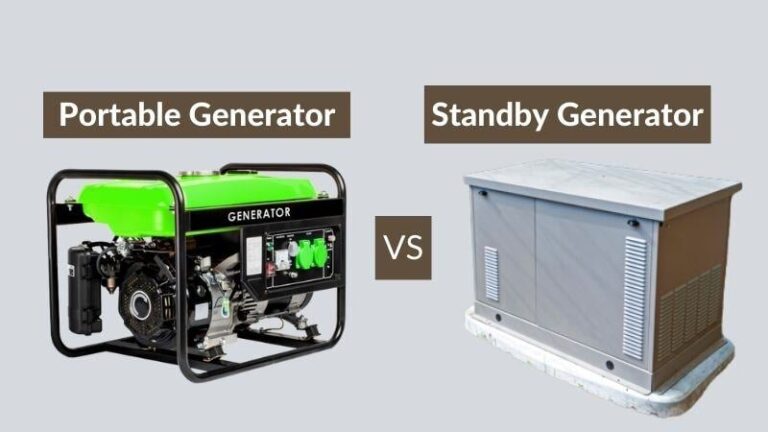Florida homeowners know that power outages are more than a minor inconvenience. From hurricane-related blackouts to unexpected utility failures, having a backup power system can make all the difference in safety, comfort, and peace of mind.
But what’s the right choice for your home—a portable generator or a standby generator?
Let’s break down the real-world pros, cons, contractor requirements, and Florida-specific considerations so you can choose confidently.
Overview: What’s the Difference?
Portable Generators
Portable generators are compact, movable units typically powered by gasoline or propane. Though they seem simple, safe home use requires professional electrical work, including an inlet and manual transfer system.
Power Output: 3–15+ kW
Use Case: Short outages, powering essentials
Fuel: Gasoline or propane (stored on-site)
Standby Generators
Standby generators are permanent fixtures wired directly to your electrical system. They power your home automatically during an outage and run on propane or natural gas from your utility or a tank.
Power Output: 10–26 kW
Use Case: Long-term outages, full-home or partial backup
Fuel: Natural gas or propane (hard-piped)
Contractor Requirements (Florida)
| Task | Portable Generator | Standby Generator |
|---|---|---|
| Electrical Contractor | ✅ Required – to install inlet box & transfer switch | ✅ Required – to connect generator to home panel |
| Gas Contractor (LP/Natural) | ❌ Not usually needed (fuel is portable) | ✅ Required – to connect to gas utility or tank |
| HVAC Technician | ⚠️ Not always – needed if soft start system will be used to run A/C | ✅ Recommended – if HVAC systems are tied into backup |
| Structural Contractor | ❌ Not needed | ✅ May be required – to pour concrete pad or platform |
| Permits Required | ⚠️ Almost always | ✅ Always – electrical + gas + possible zoning permits |
| HOA Approval | ❌ Unlikely | ⚠️ Often required – especially in deed-restricted communities |
Pro Tip: Always check with your local permitting office and HOA before purchasing a standby generator. Enclosures, sound levels, and placement are often regulated.
Portable vs. Standby: Detailed Comparison
| Feature | Portable Generator | Standby Generator |
|---|---|---|
| Initial Cost | $700–$2,000+ for unit + $800–$1,500+ for safe install | $5,000–$20,000+ (installed and permitted) |
| Power Output | 3–15+kW – Fridge, lights, electronics small AC (varies by size) | 10–26 kW – Whole home including HVAC |
| Startup | Manual (but push-button and electric start are available) | Fully automatic within seconds of outage |
| Fuel Source | Gasoline or propane – must be refilled manually | Natural gas (utility) or large propane tank |
| Noise Level | Inverter models are quieter; large units can be loud | Quieter, sound-insulated enclosures |
| Installation | Requires pro installation for inlet & transfer switch | Requires pro install, gas hookup, and pad |
| Permits Required | Yes (for electrical) | Yes – electrical, gas, structural, HOA approval |
| Mobility | ✅ Portable—but some units weigh over 100 lbs and require wheels or carts | ❌ Fixed installation only |
| Maintenance | Owner-performed (oil changes, spark plugs) | Needs professional maintenance (every 6–12 months) |
Important Considerations
Installation for Portable Generators
Even though they’re portable, using a generator to safely power your home circuits requires:
- Electrical permit
-
A generator inlet box (usually 30A or 50A)
-
A manual transfer switch or breaker interlock kit
-
Professionally installed wiring from inlet to panel
-
Weather-rated cover if placed outdoors
Total installed cost: $2,000–$5,000+ including generator, depending on complexity and local labor rates.
Installation for Standby Generators in Florida
Standby generator projects in Florida require:
-
Electrical permit (panel integration with ATS – Automatic Transfer Switch)
-
Gas permit (for natural gas or propane connection)
-
Zoning approval (setback rules, noise limits)
-
Flood elevation compliance (e.g., raised platform in flood-prone areas)
-
Concrete pad or hurricane-rated mounting system
-
HOA approval in many deed-restricted communities
Example: Some HOAs limit generator noise to <70 dB and require that the unit be screened with landscaping or fencing.
Total installed cost: $5.000–$20,000+ including generator, depending on complexity and local labor rates.
Weight & Mobility: Don’t Overlook This!
While “portable” sounds convenient, these units can still be heavy:
-
3–6 kW generators: <80–100 lbs
-
7–15kW models: ~150–250 lbs
Pro Tip: Look for models with wheels, fold-down handles, and electric start to make operation easier. Storing the generator and moving it into position can be a chore, especially during a storm.
Generator Sizing: What Do You Really Need?
Here’s a rough power breakdown to help you size your system:
| nce/System | Approx. Watts (Running) |
|---|---|
| Refrigerator | 600–800 W |
| Window AC Unit | 1,000–1,500 W |
| Central AC (3-ton) | 3,500–4,500 W |
| Electric Water Heater | 3,000–4,500 W |
| Wi-Fi + Lights | 500–1,000 W |
Portable: Good for 1–2 appliances + the basics + A/C when used in conjunction with a soft start system
Standby: Can run the whole home, including HVAC, water heater, washer/dryer, etc.
You may also be interested in: How to Choose the Right Sized Generator
You may also be interested in: Can a Portable Generator Run My A/C?
Final Thoughts
-
If you’re looking for affordability and flexibility, a portable generator (properly installed) could be a great fit—just be ready to manage fuel, setup, and storage.
-
If you want hands-off operation, full-home coverage, and peace of mind during long outages, a standby generator is the gold standard—especially in storm-prone areas like Florida.
Either way, partner with licensed professionals and check local codes and HOA rules to avoid costly surprises.
You may also be interested in: Need Help With Your Generator? Here’s How to Reach the Experts

